10 Best Substrates for Goldfish in 2022: Reviews & Top Picks
Some people prefer to keep their goldfish tanks bare bottom for ease of cleaning, but substrate can bring a lot of interest to your tank, as well as providing an anchor for many plants. Finding the right substrate for your goldfish tank doesn’t have to be painful, but it is something you want to choose carefully to ensure you don’t have to pull substrate out to replace it with something better. There are tons of substrate options in all different colors, textures, and sizes, so you have plenty of products to choose from. These reviews bring together the 10 best substrates for goldfish tanks to make finding the best substrate for your goldfish tank easy and painless.
A Quick Comparison of Our Favorites
The 10 Best Substrates for Goldfish – Reviews 2022
1. FairmountSantrol AquaQuartz Pool Filter Sand
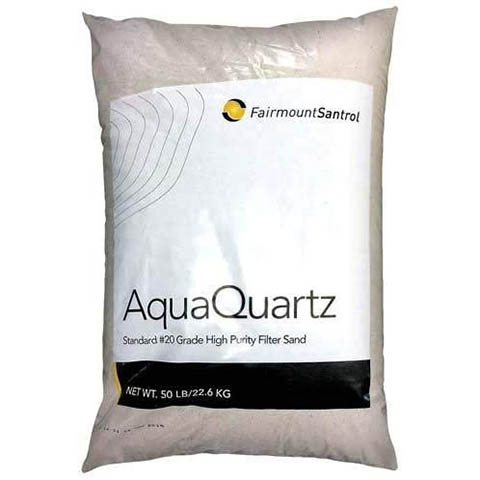
| Texture: | Fine |
| Sizes: | 50 pounds, 150 pounds |
| Color Options: | White |
| Cost Score: | $ |
One of the best substrate options for goldfish tanks isn’t made for aquariums at all! FairmountSantrol AquaQuartz Pool Filter Sand is extremely cost effective and safe for aquariums. Quartz sand won’t alter your water parameters, so no worries about it changing your pH or water hardness. Since this sand is made for pool filters, it’s made to not clump, which means you don’t have to worry about thick clumps of sand in the bottom of your tank. Sand is a great substrate for goldfish because they’re unlikely to accidentally ingest enough of it to harm them and it won’t get stuck in their mouths. Many plants grow well in sand, although you may need root tabs to help them along.
Sand should be stirred from time to time to prevent buildup of gas pockets, although burrowing fish and snails and plants with large root systems can fix this issue as well. It is lightweight enough that your goldfish will uproot plants without a second thought, so you may need to invest in plant weights.
2. AquaTerra Aquarium Sand
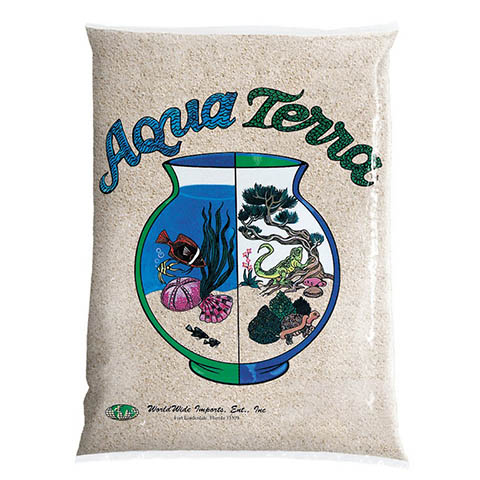
| Texture: | Fine |
| Sizes: | 5 pounds |
| Color Options: | White, black |
| Cost Score: | $$ |
For another sand option, AquaTerra Aquarium Sand is a good pick that’s available in two colors. It’s a cost-effective option, although you will have to buy multiple bags for tanks over 5 gallons. This sand has a safe acrylic coating that keeps it colorfast and doesn’t allow colors to leach into your tank water. It also provides a large surface area for the colonization of beneficial bacteria, improving your water quality. This sand shouldn’t create large clumps in your tank and is small enough that your goldfish are unlikely to accidentally ingest it.
Your plants may need root tabs and plant weights in this substrate, and you will need to stir it or introduce plants or animals that will keep the substrate turned. This sand is only available in 5-pound bags, meaning you will need multiple bags for large tanks.
3. WAYBER Decorative Crystal Pebbles

| Texture: | Smooth gravel |
| Sizes: | 1-pound |
| Color Options: | Mixed |
| Cost Score: | $$$$ |
The WAYBER Decorative Crystal Pebbles are a gorgeous substrate option for your goldfish tank. These pebbles are the size of small to large gravel and are a mixture of translucent cool colors, like blue, green, and purple, with clear pieces mixed in. These pebbles are not made specifically for aquariums, but they are safe for aquarium use and will not alter your water parameters. One benefit to gravel is that it is typically heavy enough to help hold plants in place, although it may not be strong enough with goldfish that are insistent on uprooting plants.
It’s important to note that there have been some anecdotal reports of goldfish getting gravel stuck in their mouths. If your goldfish are still small or if they are very large, this is unlikely to be an issue. If your goldfish are the size that gravel could get stuck in their mouths, then keep a close eye on them as they adjust to the new substrate. This gravel is only available in 1-pound bags and is a premium price for the package size.
4. Pisces Midnight Pearl Aquarium Gravel

| Texture: | Smooth gravel |
| Sizes: | 4 pounds, 11 pounds, 22 pounds |
| Color Options: | Mixed |
| Cost Score: | $$$ |
The Pisces Midnight Pearl Aquarium Gravel is a naturally beautiful gravel option for your aquarium. This gravel is sourced from New Zealand and is naturally occurring colors and sizes. It is smaller than most aquarium gravel, but it is heavy enough to avoid being sucked up during gravel vacuuming. The combination of multiple natural colors, including grey, tan, white, and black, is attractive and has a pearlescent shimmer underwater. This gravel won’t alter your water parameters and won’t leach colors into the tank.
Rinse this gravel thoroughly prior to use to ensure you don’t introduce dust into the tank. These rocks are naturally smoothed, they are not coated or polished, so you may get rough pieces in the bag, which is to be expected.
5. GloFish Fluorescent Aquarium Gravel
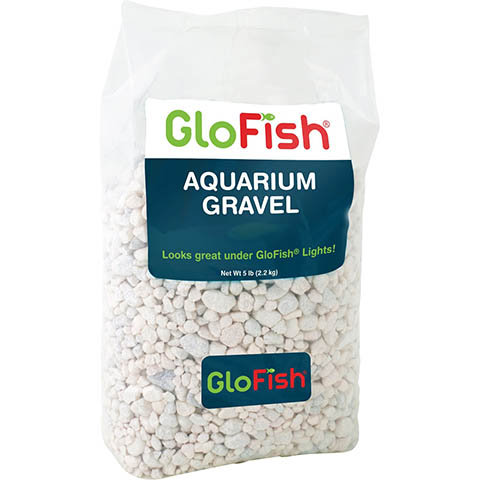
| Texture: | Smooth gravel |
| Sizes: | 5 pounds |
| Color Options: | Green, pink, white, black, mixed |
| Cost Score: | $$ |
If you’re looking for something a little bit funky, then the GloFish Fluorescent Aquarium Gravel may be what you’re looking for. This gravel is made to glow under GloFish blue LED lights, but it will still have a striking glow if you don’t have GloFish brand lights. Even under normal white lighting, the bright colors of this gravel will make it stand out. This gravel is smooth and made to not leach colors into the water. It’s a combination of small to large gravel pieces and is available in multiple color options, including a combo color pack. This gravel shouldn’t alter your water parameters.
This gravel may become stuck in goldfish’s mouths, especially the smaller pieces, so keep an eye out for this. It’s only available in 5-pound bags, so you will need multiple bags for larger tanks.
6. Seachem Fluorite Black Sand
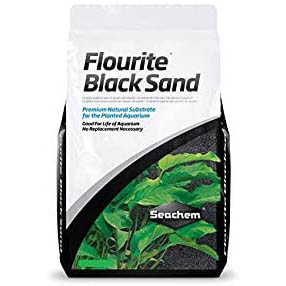
| Texture: | Fine |
| Sizes: | 4 pounds |
| Color Options: | Black |
| Cost Score: | $$$ |
The Seachem Fluorite Black Sand is a natural product that is made from highly porous clay, which allows this sand to be a great way to colonize beneficial bacteria. It will not alter water parameters but can help grow healthy plants and is designed for planted aquariums. This sand is more of a charcoal black than dark black, but it is difficult to tell the difference once it’s settled into a tank. It’s not coated with acrylic or other chemical coatings because the color is naturally occurring, so it will not leach color into your water.
This sand requires thorough rinsing multiple times before use. Otherwise, it will quickly cloud your tank and may take a few days to full settle. If not rinsed well, you may have to use filter floss to filter out dust and floating particles and you may even need to skim the water with a net to remove floating particles on the surface. This sand is made to help hold plants into place, but until roots are established, goldfish may uproot plants.
7. Exotic Pebbles & Aggregates White Bean Pebbles
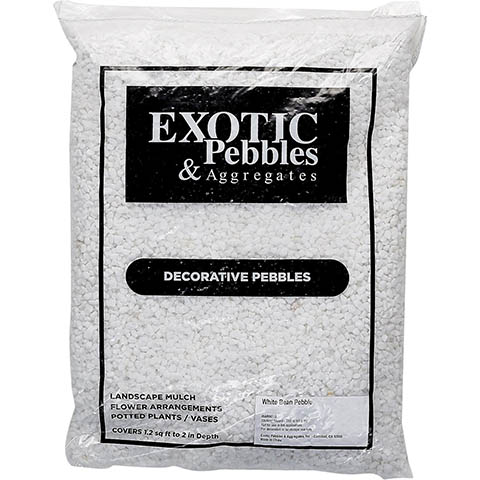
| Texture: | Smooth gravel |
| Sizes: | 5 pounds, 20 pounds |
| Color Options: | White |
| Cost Score: | $ |
The Exotic Pebbles & Aggregates White Bean Pebbles are a cost-effective option for gravel. These white pebbles are small and smooth and are available in two bag sizes. These pebbles are naturally white, so they will not leach color into the tank. They are eco-friendly and are sourced from multiple quarries across the world. While each pebble is a unique size and shape, they are all approximately 1/5-inch each. These pebbles will not alter your water parameters.
Since this is gravel, it’s possible for it to become stuck in your goldfish’s mouth, so monitor this. They require thorough rinsing to prevent white dust from getting into the tank. Even with adequate rinsing, you may see particulate float up when you disturb the gravel for cleaning or planting.
8. Stoney River White Aquatic Sand

| Texture: | Coarse |
| Sizes: | 5 pounds, 10 pounds, 15 pounds, 20 pounds |
| Color Options: | White |
| Cost Score: | $$$$ |
The Stoney River White Aquatic Sand is a good pick if you prefer a coarse sand for your aquarium. It’s available in multiple pack sizes but is only available in white. This sand has a non-toxic coating on it to prevent color or chemical leaching into the water. It will not alter water parameters. This sand is unique in that it’s wet sand, which means it arrives wet and pre-seeded with beneficial bacteria, which can help to cycle a tank faster and can help fix a crashed cycle. Many types of wet sand are made for saltwater tanks, but this sand is labeled for freshwater and saltwater use.
Be aware that this sand may cause your water to be cloudy until the beneficial bacteria has settled in the tank. Rinsing this sand will remove the benefit of purchasing wet sand. This product is a premium price because it is wet sand. Also, since this sand is a coarse texture, it’s possible for it to tear long fins, like those on most fancies.
9. Landen Namale Sand

| Texture: | Coarse |
| Sizes: | 4 pounds, 11 pounds |
| Color Options: | Natural |
| Cost Score: | $$$$ |
The Landen Namale Sand is made to provide a natural look to your tank, especially if you are attempting to create an underwater “forest” look. The naturally occurring colors include white, black, and tan, and the sand is a slightly coarse grain. There are two bag sizes available but no color options other than natural. This sand will not alter water parameters and is unlikely to be ingested by your goldfish.
This product is a premium price and doesn’t provide many options. It should be thoroughly rinsed prior to use to prevent water clouding. It’s a natural product, so water clouding may occur, even with adequate rinsing. This sand is lightweight, making it prone to being pulled into the gravel vac during tank cleanings.
10. Landen Aqua Soil Substrate
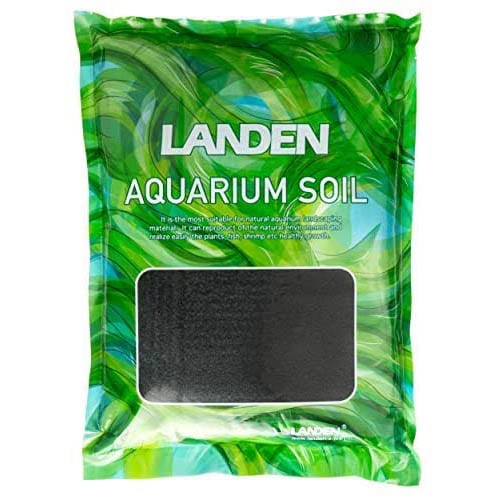
| Texture: | Coarse |
| Sizes: | 10 pounds |
| Color Options: | Black |
| Cost Score: | $$$$ |
For a planted tank, the Landen Aqua Soil Substrate can make a good selection. It’s made from porous clay, so it helps colonize beneficial bacteria. It’s a naturally occurring color, so it won’t leach colors into your tank. This substrate is made specifically to allow for plants to adequately form roots through it. It does not require rinsing before use, although it’s recommended.
This substrate can alter your water parameters, softening your water and lowering your pH to acidic levels. This substrate is better for blackwater tanks and other tanks with acid-loving fish but can be used in goldfish tanks. You will have to monitor water parameters routinely, though, and you will likely have to add products to keep your pH and water hardness up.
Buyer’s Guide
Choosing the Right Substrate for Your Goldfish Tank
Color
There are plenty of color options for substrate in goldfish tanks, so you can take your pick! Some people prefer a more natural look, while others prefer something bright and fun. You can pick artificially colored substrate if you’re looking for something bright. Just make sure anything you use is aquarium safe and isn’t going to leach polishing or cleaning chemicals into your tank.
Texture
Texture is based on your preference and the inhabitants of your tank. If you like a smooth, unnoticeable texture, then sand is a great option. For something more dramatic, gravel or river rocks can be good picks. You can even combine different textures to create interest in your tank. Just remember that anything heavy you put on top of a lighter substrate will eventually sink, so gravel and rocks on top of sand won’t work for long. Also, take your fish into account. If you have fancies or long-finned goldfish like comets, then you may want to avoid anything with sharp or jagged edges and stick to softer substrates that won’t tear fins.
Related Read: 5 Best Electric Aquarium Vacuum Gravel Cleaners in 2021 – Reviews & Top Picks
Plants
Different plants have different needs, so having an idea of the type of plants you want in your tank will help you pick a substrate. Plants like Java Fern and Anubias will draw nutrients from the water column, so substrate won’t have an effect on their growth and health. However, plants like Vallisneria and Crypts require nutrient-rich substrate to grow in. This can be accomplished with the substrate itself, but root tabs are always an option if your substrate is void of nutrients, which is the case with most sand, gravel, and rocks.
Parameters
Most substrates for freshwater tanks aren’t going to have a major impact on your water parameters. However, it’s important to understand that some of them do. Aragonite and crushed coral are intended for saltwater tanks and can significantly alter your water parameters. Substrates made to be nutrient-rich for planting are often going to alter your water parameters as well.
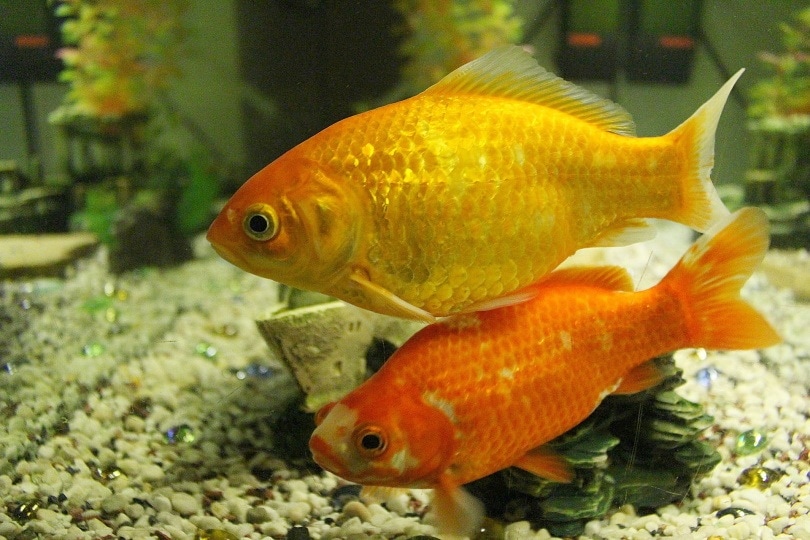
Substrate Options for Goldfish Tanks
Sand: This is a great option for a smooth substrate look. It’s available in natural and unnatural colors and is great for plants that prefer a soft substrate or that have large root systems that like to sprawl.
Gravel/Pebbles: The quintessential aquarium substrate, gravel and pebbles are a chunkier substrate that is between sand and rocks. It isn’t nutrient-rich, but it does allow plants that like to have a more solid substrate to root into to root well and be healthy. Some plants won’t be able to push their roots through gravel, so choose your plants and substrate wisely.
Rocks: Rocks, like river rocks, can make an attractive addition to aquariums, depending on the look you’re going for. Some rocks will alter water parameters, so make sure you know what type of rocks you’re adding to your tank. Any rocks pulled from nature should be thoroughly cleaned before adding to your tank. Rocks are a good pick for plants that like to grow on hard surfaces, like Java Fern.
Clay: Clay substrate tends to allow for excellent beneficial bacteria growth and plant nutrition. Some clay substrates will have no effect on your water parameters, but many of them will lower your pH and are better suited for planted blackwater and other acidic tanks.

Conclusion
FairmountSantrol AquaQuartz Pool Filter Sand and AquaTerra Aquarium Sand are both great options for sand substrate, while the WAYBER Decorative Crystal Pebbles are a beautiful tank addition at a premium price. If you’re unsure of the texture or weight of substrate you’re interested in, purchase multiple types so you can feel them in your hands and return what you don’t need. Plan to purchase around 1 pound of substrate for every gallon of water your tank holds, regardless of the type of substrate. These reviews are a guide and a starting point to help you choose your substrate.
Featured Image Credit: hineck, Pixabay



Không có nhận xét nào